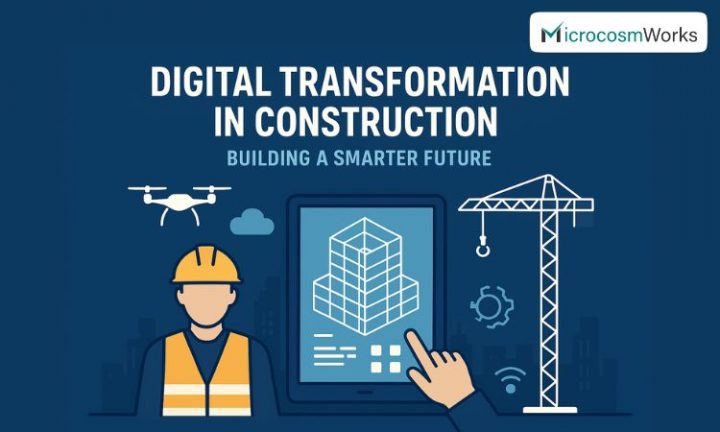The construction industry has always been one of the most essential sectors in the world, shaping cities, infrastructure, and the very spaces we live and work in. But for a long time, construction processes remained traditional, relying heavily on manual labor, paper-based designs, and face-to-face coordination. Today, the sector is undergoing a massive shift with the rise of digital transformation in construction. From smart project management tools to advanced building technologies, digital adoption is redefining how projects are planned, executed, and delivered.
In this article, we’ll explore what digital transformation means for construction, its benefits, challenges, and the technologies driving this change.
What is Digital Transformation in Construction?
Digital transformation in construction refers to the integration of modern digital tools, software, and technology-driven processes into every stage of a project lifecycle. Instead of using outdated paper-based methods, companies now use digital platforms to design, plan, monitor, and execute their work.
This transformation doesn’t just mean adopting new software—it’s a complete cultural shift that changes the way teams collaborate, how data is used, and how projects are delivered more efficiently and sustainably.
Why Digital Transformation Matters in Construction
Construction projects are often large-scale, complex, and involve multiple stakeholders—architects, engineers, contractors, suppliers, and clients. Without streamlined communication and accurate data, projects can face delays, budget overruns, and errors.
Digital tools bring a new level of transparency and efficiency. With real-time updates, accurate design models, and connected workflows, companies can save both time and money while improving quality and safety.
Key Technologies Driving Digital Transformation in Construction
Several emerging technologies are reshaping the construction sector. Here are the most impactful ones:
1. Building Information Modeling (BIM)
BIM is one of the most powerful innovations in construction. It allows engineers, architects, and contractors to create a 3D digital model of a building before construction begins. This model includes not only the design but also crucial information about materials, costs, and timelines.
- Helps identify errors before construction.
- Improves collaboration between teams.
- Reduces material waste and cost overruns.
2. Cloud-Based Project Management
Cloud platforms allow teams to work together from anywhere in the world. Project managers can assign tasks, track progress, and share updates in real-time. This is especially valuable for large infrastructure projects where multiple teams work across different locations.
3. Internet of Things (IoT)
IoT devices are transforming job sites. Sensors can monitor equipment usage, track worker safety, and even measure environmental conditions such as temperature or dust levels. This creates a safer and more efficient workplace.
4. Drones and Robotics
Drones are now widely used for surveying land, inspecting structures, and tracking progress. Robotics are used for repetitive or dangerous tasks such as bricklaying or concrete pouring, reducing risks and increasing efficiency.
5. Artificial Intelligence and Predictive Analytics
AI-powered tools can analyze project data to predict potential risks, delays, or cost issues. For example, predictive analytics can help project managers forecast when a project may run over budget and suggest solutions before problems occur.
6. Virtual Reality (VR) and Augmented Reality (AR)
VR and AR allow clients and contractors to virtually “walk through” a building before it is built. This improves design accuracy, reduces misunderstandings, and enhances client satisfaction.
Benefits of Digital Transformation in Construction
Adopting digital tools brings measurable benefits across the industry.
- Improved Efficiency – Automation and digital workflows cut down time wasted on manual tasks and paperwork.
- Cost Savings – Accurate planning reduces rework and unnecessary material usage.
- Better Collaboration – Cloud-based systems allow architects, engineers, and contractors to work seamlessly.
- Enhanced Safety – Wearables and IoT sensors improve worker monitoring and site safety.
- Higher Quality Projects – With better designs and real-time data, construction quality improves significantly.
- Sustainability – Digital modeling and smart monitoring reduce waste and energy usage, supporting green building practices.
Challenges in Digital Transformation
While the benefits are clear, construction companies still face challenges in going digital.
- High Initial Costs – Advanced tools like BIM or robotics require significant investment.
- Resistance to Change – Many professionals are used to traditional methods and may hesitate to adopt new systems.
- Training Needs – Employees must be trained to use new tools effectively.
- Data Security – With increased digitalization comes the risk of cyber threats and data breaches.
To overcome these barriers, companies need strong leadership, proper training programs, and a long-term vision for digital adoption.
Real-World Applications of Digital Transformation
Across the globe, leading construction firms are adopting digital solutions:
- Smart Cities – Governments are using digital tools to design and manage sustainable urban spaces.
- Infrastructure Projects – Drones and BIM models are widely used in road, rail, and bridge construction.
- Residential Buildings – Digital platforms streamline design approvals and speed up construction timelines.
These real-world applications prove that digital transformation is no longer a luxury—it’s a necessity for staying competitive.
The Future of Construction
The future of construction will be driven by smart technologies and data-driven decision-making. As the industry continues to digitize, we can expect:
- Fully automated construction sites with robotics.
- AI-powered planning that eliminates delays and budget overruns.
- Wider adoption of green and sustainable practices.
- Increased use of digital twins—virtual replicas of buildings that monitor performance even after completion.
Companies that embrace digital transformation today will be the leaders of tomorrow’s construction industry.
Conclusion
Digital transformation in construction is no longer an option—it’s the path forward. By adopting modern technologies such as BIM, cloud platforms, IoT, drones, and predictive analytics, the construction sector can achieve higher efficiency, lower costs, improved safety, and sustainable growth.
While challenges like cost, training, and resistance to change exist, the benefits far outweigh the drawbacks. The construction industry has entered a new era where digital tools will shape smarter, safer, and more sustainable projects for generations to come.
Read More:




